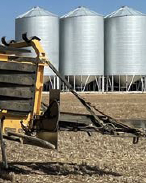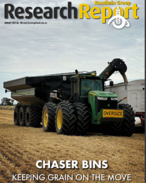This article is 4 years old. Images might not display.
Kondinin Group Research engineer Ben White, who is a member of the Grains Research and Development Corporation (GRDC) Stored Grain Extension team, said there were several key points growers needed to keep front of mind when it came to storing grain with high moisture levels.
"The current weather conditions have seen some high moisture cereal and oilseed grain harvested," White said.
"To avoid delivery or storage quality problems, growers need to act quickly once high moisture grain is harvested. Grain respires like most living organisms, which means it takes in oxygen to use with carbohydrates, which in turn generates carbon dioxide, water and heat.
"When grain has a high moisture content and is warm, the rate of respiration increases significantly, causing it to heat.
"This can result in serious grain damage of ‘bin burn and creates ideal conditions for moulds and insect pests," White said.
In situations where growers need to harvest early and temporarily store high moisture grain, it is critical they have aeration cooling, as well as clear plans to dry grain or blend grain within three to five weeks.
Helpful tactics by GRDC for silo set up for temporary storage of high moisture grain include:
- Regularly check grain temperature with the aim of keeping it below 25 degrees Celsius. It is important to remember it is the average relative humidity of the air being used while fans are running that is important. Short run periods for one or two hours of high humidity air during a storm should not cause a problem provided this is promptly followed by lower average relative humidity air (30 to 65 per cent relative humidity).
- If available, use an automatic aeration controller set on ‘auto continuous'. This automatically turns the fan off for a short time when air exceeds 85 per cent relative humidity.
- Do twice daily checks on grain temperature (use a grain probe), check silo fan operation and smell grain at the top of the silo.
- To keep grain cool, run aeration fans continuously (24/7) as soon as the first truck load of moist grain goes into a silo or shed. Ideally, use a silo with aeration ducting that provides effective air distribution through the wet grain. Silos with a wide base may require at least two fans opposite each other. Ensure silo roof vents or the top silo lid is open enough to ensure airflow is not restricted. Aeration fans need to be delivering airflow rates of at least 2-4 Litres per second per tonne.
- Consider only filling two-thirds of the silo to reduce the grain depths and effectively increase air flow.
- If manually operating fans, growers should monitor the ambient temperature and relative humidity on-farm. If the weather is wet and humidity is consistently above 85 per cent, fans should be turned off fans for short periods (two to four hours).
- ‘Turning grain' could be considered. After two to four days of having wet grain in the silo, auger the grain into the truck, then back into the silo. Moving grain around and turning it over helps to break up hot spots that can develop in the silo. This may be helpful if the aeration air distribution system/ducting is limited.
For more advice from the GRDC Grain Storage Extension team call 1800 WEEVIL.






















